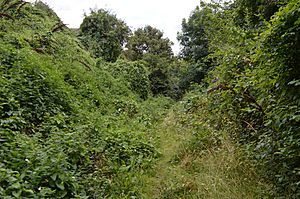Lion Pit facts for kids
| Site of Special Scientific Interest | |
 |
|
| Area of Search | Essex |
|---|---|
| Interest | Geological |
| Area | 2.5 hectares |
| Notification | 1986 |
| Location map | Magic Map |
Lion Pit is a special place in Grays, Essex. It covers 2.5 hectares, which is about the size of five football fields! This area is very important for its geology, meaning its rocks and landforms.
It's officially known as a Site of Special Scientific Interest (SSSI). This means it's protected because of its unique natural features. Lion Pit is also part of the Chafford Gorges Nature Park, which is managed by the Essex Wildlife Trust.
Contents
A Glimpse into the Past at Lion Pit
Lion Pit was once a path for a tramway in the 1800s. This tramway moved chalk to boats on the river. But this site holds much older secrets than just a tramway.
Who Lived Here Long Ago?
Scientists have found amazing clues at Lion Pit. They discovered evidence that Neanderthal people lived here about 200,000 years ago! These early humans were skilled at making tools.
They used a technique called flint-knapping. This is where they carefully chipped pieces off flint stones to make sharp tools. At Lion Pit, experts have even managed to fit some of these tiny flint pieces back together, like a puzzle! This shows exactly how the Neanderthals made their tools.
What Ancient Animals Roamed Here?
Besides human tools, many old animal bones have been found at Lion Pit. These are called fossils. They tell us about the huge animals that lived here a very long time ago.
Some of the fossils found include giant rhinoceroses, bison, mammoths, and even straight-tusked elephants. Imagine these huge creatures walking around where Grays is today!
Visiting Lion Pit Today
If you want to explore Lion Pit, there's a public footpath that goes right through the site. You can access it from Weymouth Drive or London Road. It's a great place to imagine what life was like thousands of years ago.

